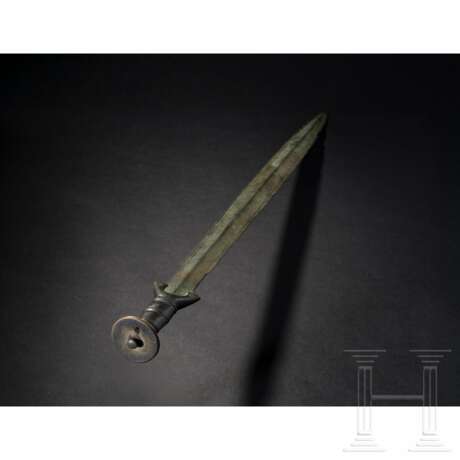Urnenfelderzeitliches Vollgriffschwert vom Typus "Schwaig", Stufe Hallstatt A1, 12. Jhdt. v. Chr.
03.11.2025 12:00UTC +01:00
Classic
Sold
10000EUR € 10 000
| Auctioneer | Hermann Historica |
|---|---|
| Event location | Germany, Grasbrunn / München |
| Buyer Premium | 25 % |
Archive
The auction is completed. No bids can be placed anymore.

ID 1478453
Lot 38 | Urnenfelderzeitliches Vollgriffschwert vom Typus "Schwaig", Stufe Hallstatt A1, 12. Jhdt. v. Chr.
Die Klinge weidenblattförmig mit geringfügig auswärts gebauchten Schneiden. Die ca. 4 mm breiten Schneiden durch einen Absatz deutlich vom massiven Mittelteil der Klinge mit einem kräftigen Mittelgrat abgesetzt. Unterhalb des trapezoiden Oberteils der Klinge eine eingezogene, gekerbte Fehlschärfe (Ricasso) von etwa 4,5 cm Länge. Der trapezoide Abschluss der Klinge durch einen massiven Griff im Überfangguss eingeschlossen. Am unteren Ende der nach innen eingezogenen Randeinfassung, unterhalb des Griffes mit drei schmalen Wülsten, auf beiden Seiten je ein eingravierter Scheinniet. Am obersten Ende der Einfassung Spiraldekor, der zum Rand hin etwas abgegriffen ist. Die drei Wülste des leicht gebauchten Griffes mit senkrechten Kerben verziert. Darüber der konische Knauf mit oben flachem Abschluss. Auf der Unterseite punzverziert, mit zwei Reihen aus gegenständigen Dreiecken. Auf der Oberseite Kreisaugen in den Tälern und Bergen einer Wellenlinie. In der Mitte ein zylindrischer Knaufkopf umgeben von drei Kreislinien. Der Knauf auf einer Seite durchlocht für ein Lederband zur Sicherung des Schwerts an der Hand. Schöne dunkelgrüne Patina. Geringfügige Ausbrüche auf beiden Seiten kurz vor der Spitze. Ansonsten im mittleren Bereich der Klinge mehrere Scharten durch massives Schlagen auf eine Kante. Diese Beschädigungen sind wohl nicht auf Kampfhandlungen, sondern eher auf eine rituelle Beschädigung der Waffe vor ihrer Deponierung zurückzuführen. Dergleichen rituelle Beschädigungen (u.a. auch Verbiegen oder Zerschlagen in mehrere Teile) kommen bei Fundstücken dieser Zeitstellung häufig vor. Das Gesamtbild des ansonsten ausgezeichnet erhaltenen spätbronzezeitlichen Schwerts wird dadurch jedoch kaum beeinträchtigt. Länge 66,3 cm.
KULTURGUT!
Provenienz: Süddeutsche Privatsammlung.
A fully-hilted sword from the Urnfield period, type "Schwaig", Hallstatt A1 stage, 12th century B.C.
A fully-hilted sword from the Urnfield period, type "Schwaig", Hallstatt A1 stage, 12th century B.C.
The blade is willow leaf-shaped with slightly outwardly curved cutting edges. The approx. 4 mm wide cutting edges are clearly separated from the solid middle section of the blade with a strong central ridge by a step. Below the trapezoidal upper section of the blade is a recessed, notched ricasso (blunt edge) approx. 4.5 cm long. The trapezoidal end of the blade is enclosed by a solid handle in overlay casting. At the lower end of the inwardly indented edge below the handle, there are two engraved blind rivets on both sides. At the upper end of the edge, there is a spiral decoration, which is slightly worn towards the edge. The three bulges of the slightly bulging handle are decorated with vertical notches. Above this is the conical pommel with a flat top. The underside is decorated with two rows of opposing triangles. On the top are circular eyes in the fields between a wavy line. In the center is a cylindrical pommel head surrounded by three circular lines. The pommel is pierced on one side for a leather strap to secure the sword to the hand. Beautiful dark green patina. Minor chips on both sides just before the tip. Otherwise, several nicks in the middle of the blade caused by heavy blows against an edge. This damage is probably not due to combat, but rather to ritually damaging the weapon before it was deposited. Such ritual damage (including bending or smashing into several pieces) is common in finds from this period. However, this hardly detracts from the overall appearance of this otherwise excellently preserved Late Bronze Age sword. Length 66.3 cm.
Provenance: Süddeutsche Privatsammlung.
Condition: II
| Auction house category: | European Stone and Bronze Age |
|---|
| Auction house category: | European Stone and Bronze Age |
|---|
| Address of auction |
Hermann Historica Bretonischer Ring 3 85630 Grasbrunn / München Germany | ||||||||||||||
|---|---|---|---|---|---|---|---|---|---|---|---|---|---|---|---|
| Preview | |||||||||||||||
| Phone | +49 (0)89 5472 649 0 | ||||||||||||||
| Fax | +49 (0)89 5472 64999 | ||||||||||||||
| Buyer Premium | 25 % | ||||||||||||||
| Conditions of purchase | Conditions of purchase | ||||||||||||||
| Business hours | Business hours
|


